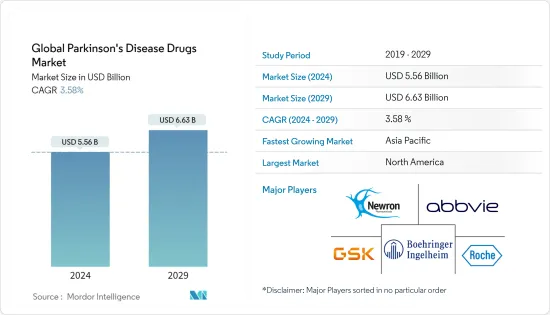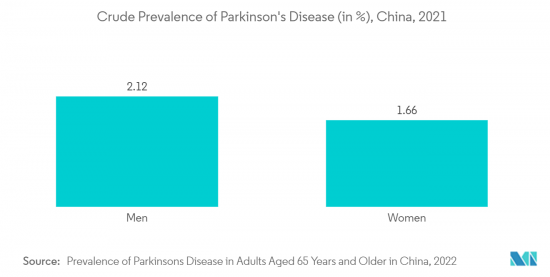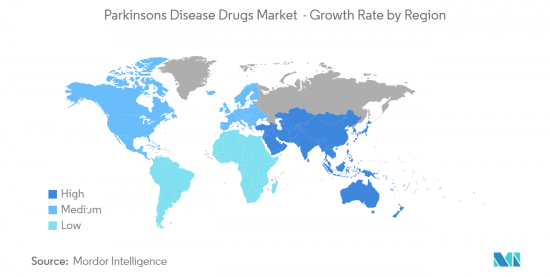
|
市場調査レポート
商品コード
1429236
世界のパーキンソン病治療薬:市場シェア分析、産業動向と統計、成長予測(2024年~2029年)Global Parkinson's Disease Drugs - Market Share Analysis, Industry Trends & Statistics, Growth Forecasts (2024 - 2029) |
||||||
カスタマイズ可能
適宜更新あり
|
|||||||
| 世界のパーキンソン病治療薬:市場シェア分析、産業動向と統計、成長予測(2024年~2029年) |
|
出版日: 2024年02月15日
発行: Mordor Intelligence
ページ情報: 英文 115 Pages
納期: 2~3営業日
|
- 全表示
- 概要
- 目次
世界のパーキンソン病治療薬市場規模は2024年に55億6,000万米ドルと推定され、2029年には66億3,000万米ドルに達すると予測され、予測期間中(2024-2029年)のCAGRは3.58%で成長する見込みです。

COVID-19パンデミックは市場に大きな影響を与えました。COVID-19のパンデミックは、パーキンソン病治療薬市場の世界市場にほとんど大きな影響を与えませんでした。パンデミックはパーキンソン病治療薬の生産と需要に直接的な影響を及ぼし、流通チャネルを混乱させ、企業や金融市場に財務的な影響を与えました。しかし、臨床試験は増加し、PD患者に対するCOVID-19の影響を見つけるために数多くの調査が行われています。例えば、2021年8月に発表された論文「Clinical Trials of Parkinson's Therapies Robust Despite COVID-19」では、COVID-19の影響にもかかわらず、パーキンソン病の潜在的な新治療法の臨床試験に対する投資と関心は、パンデミック期においても堅調であったと述べられています。また、同月には「Parkinson's Disease Drug Therapies in the Clinical Trial Pipeline:2021 Update(臨床試験パイプラインにおけるパーキンソン病研究開発:2021年最新版)」と題する調査論文も発表されており、この論文によると、パンデミック期には、神経変性疾患であるパーキンソン病(PD)に対する革新的かつ効率的な薬剤ベースの治療法の臨床開発がかなり活発に行われていました。そのため、パンデミックは前述の要因から、調査対象の市場にプラスの影響を与えると予想されます。
高齢者人口の増加やパーキンソン病の負担の増加、国民の意識の高まり、研究開発の増加、継続的な薬剤の承認などの要因は、市場の成長を促進すると予想されます。
例えば、パーキンソン病の世界の有病率は約610万人と推定され、有病率は年齢とともに増加し、65歳以上の人口では1%から3%に達することが、調査記事「Monoamine Oxidase-B Inhibitors for the Treatment of Parkinson's Disease:Past, Present, and Future」が2022年2月に発表されました。さらに、世界保健機関(WHO)が2021年10月に更新したデータによると、2030年までに世界の6人に1人が60歳以上になるといいます。したがって、世界的に老年人口が増加し、人口動態が変化することが予想されます。高齢者の増加により、PDの有病率や発症率が上昇し、新しい治療薬や薬剤が求められるようになると予想されます。これにより、分析期間中の市場成長が促進されます。
さらに、大手またはマイナーな市場企業による最近の市場開拓や戦略的活動は、地域市場と世界市場の両方で増加しています。これは、調査対象市場を飛躍的に強化すると予想されるもう1つの主要因です。例えば、2021年12月、イスラエルを拠点とするPharma Two B Ltd.は、早期パーキンソン病を対象としたP2B001の第III相二重盲検能動比較試験において、主要評価項目および主要副次評価項目の達成に成功したと発表しました。P2B001は、プラミペキソール成分よりも2.66ポイント(p=0.0018)、ラサギリン成分よりも3.30ポイント(p=0.0001)優れていました。
また、2022年1月、新薬設計のための人工知能(AI)を専門とする韓国のIktos社と、難治性神経疾患治療のための革新的な新薬開発に焦点を当てた臨床・研究志向のバイオテクノロジー企業であるAstrogen社は、パーキンソン病の革新的な低分子前臨床新薬候補の創製を目的とした共同研究契約を締結しました。さらに、2022年3月には、複雑な神経発達および神経変性疾患に対する創薬の再発明に注力する革新的なバイオテクノロジー企業であるVyant Bio, Inc.と、パーキンソン病(PD)の病態を再現する独自の患者特異的オルガノイドを開発するOrganoTherapeutics社が、パーキンソン病治療薬の創薬加速に向けた共同研究契約を締結しました。したがって、パーキンソン病治療薬セグメントにおける継続的な進歩は、分析期間中の市場成長を促進すると予想されます。
したがって、上記の要因のおかげで、調査された市場は予測期間にわたって成長を示すと予想されます。しかし、医薬品や治療法の研究開発に関連するコストが高いため、医薬品のコストが高くなり、これが市場の成長を若干妨げると予測されます。
パーキンソン病治療薬市場の動向
予測期間中、MAO-B阻害薬セグメントが市場を独占する見込み
人体のモノアミン酸化酵素B型(MAO-B)酵素は、脳内のドーパミンなどを分解します。医薬品であるMAO-B阻害剤が投与されると、脳が利用できるドーパミンが増え、パーキンソン病(PD)の数多くの運動症状がこれによって軽度に改善されます。このように、MOA-B阻害剤は最近、PDの治療に使用されています。このことが、予測期間中の同分野の成長を押し上げると予想されます。
2021年12月に発表された論文『Levodopa療法でコントロールできないパーキンソン病患者におけるカテコール-O-メチルトランスフェラーゼまたはモノアミン酸化酵素B阻害薬による補助療法のドパミンアゴニストと比較した長期的有効性(Long-term Effectiveness of Adjuvant Treatment With Catechol-O-Methyltransferase or Monoamine Oxidase B Inhibitors Compared With Dopamine Agonists Among Patients With Parkinson's Disease Uncontrolled by Levodopa Therapy)』には、500人の患者を対象に研究が実施されたときのことが記載されている、モノアミン酸化酵素B型(MAO-B)阻害薬は、カテコール-O-メチルトランスフェラーゼ(COMT)阻害薬と比較して、レボドパで十分にコントロールできないパーキンソン症状の治療において優れた結果を示しました。
さらに、2021年10月に発表された別の研究論文『KDS2010, a Newly Developed Reversible MAO-B Inhibitor, as an Effective Therapeutic Candidate for Parkinson's Disease』では、モノアミン酸化酵素B(MAO-B)は確立されたパーキンソン病の治療対象(PD)であり、PD患者に頻繁に推奨される非可逆的MAO-B阻害薬としてはセレギリンやラサギリンが数例あります。これらの薬剤は、レボドパに基づくドパミン補充療法の必要性を遅らせ、副作用も比較的少ないが、複数の研究により、本物の神経保護能には限界があることが明らかにされています。PDに対するMOA-B阻害剤の有効性を見出すためのこのような調査は、このセグメントの成長を促進すると予想されます。
さらに、論文「パーキンソン病治療のためのモノアミン酸化酵素B阻害剤:Past, Present, and Future'が2022年2月に発表され、パーキンソン病の症状は一般的にモノアミン酸化酵素-B(MAO-B)阻害薬(PD)で治療されると述べられています。早期のパーキンソン病はMAO-B阻害薬単独療法で、進行期のパーキンソン病は補助薬としてMAO-B阻害薬で治療が成功しています。このように、研究開発により、セグメントの成長が期待されています。
したがって、上記の要因が予測期間中のセグメントの成長に寄与しています。

予測期間中、北米が市場を独占する見込み
予測期間中、北米はパーキンソン病(PD)治療薬市場において高い成長率を示すとみられます。北米の中では米国が大きなシェアを占めており、予測期間中は米国が市場を独占すると予想されます。これは、高いヘルスケア支出、大手市場プレイヤーの強い存在感、頻繁な製品承認、パーキンソン病患者の増加などの要因によるものです。
2021年9月に発表された記事「The Financial Burden from Parkinson's Exacts a High Cost」で提供されたデータによると、米国では推定100万人がパーキンソン病に罹患しており、毎年多くの人がパーキンソン病と診断されており、中でも65歳以上の有病率が高いです。上記の出典にあるように、PDの有病率は65歳未満でも増加しています。さらに、2022年3月に更新されたパーキンソン・カナダの全国円卓会議報告書によると、カナダでは10万人以上がPDに罹患しており、この数は今後増加し、10年以内に毎日50人が新たにPDと診断されるようになるといいます。このように、北米諸国の対象人口における本疾患の高い負担は、治療薬の開発需要を生み出すと予想されます。それにより、市場の成長が促進されます。
さらに、大手企業はこの地域での市場成長を促進する戦略的措置を講じています。例えば、UCBは2021年12月にノバルティスとUCB0599の商業化契約を締結し、UCB7853の開発をオプトインすることを発表しました。さらに、アッヴィ・インクは2022年5月、進行性パーキンソン病患者の運動機能変動に対する治療薬としてABBV-951(ホスカルビドパ/ホスレボドパ)の新薬承認申請を米国食品医薬品局(FDA)に提出しました。したがって、これらの進歩は予測期間中の同地域の市場成長を促進すると予想されます。
さらに、米国ではこの疾患の症例が増加しているため、米国やその他の地域ではFDAによる製品承認が頻繁に行われています。例えば、2022年2月には、分割を目的とした最初で唯一のカルビドパ/レボドパ(CD/LD)分画錠であるDHIVYが、Alora Pharmaceuticalsの一部門であるAvion Pharmaceuticals, LLCから市販されました。アビオンは2021年11月、米国で最も急成長している神経疾患であり、現在のところ治療法がない疾患の一つであるパーキンソン病(PD)患者に使用されるDHIVYのFDA承認を取得しました。FDAによるこのような承認は、分析期間中の市場成長に寄与すると予測されます。
したがって、前述の要因から、予測期間中、同市場は同地域で成長すると予測されます。

パーキンソン病治療薬産業の概要
パーキンソン病治療薬市場は競争が激化しています。最近の製品上市や、世界の製薬企業の製品パイプラインにある多数の治療薬が、市場のダイナミックな性質に寄与しています。予測期間中にいくつかの新製品が上市される見込みであり、現在同市場で活動している製薬企業の市場シェアに大きな変化をもたらす可能性があります。Amneal Pharmaceuticals LLC、AbbVie Inc.、Viatris、Boehringer Ingelheim International GmbH、GSK plc、ABL bio、Teva Pharmaceuticals Industries Ltd、Pfizer Inc.、Novartis AGなどが主なプレーヤーです。
その他の特典
- エクセル形式の市場予測(ME)シート
- 3ヶ月間のアナリストサポート
目次
第1章 イントロダクション
- 調査の前提条件と市場定義
- 調査範囲
第2章 調査手法
第3章 エグゼクティブサマリー
第4章 市場力学
- 市場概要
- 市場促進要因
- 老年人口の増加とパーキンソン病の負担増
- 高齢者の意識の高まり
- 研究開発の増加と継続的な医薬品承認
- 市場抑制要因
- 治療薬に関連する有害事象
- 非常に高額な研究開発費に伴う高額な治療費
- ポーターのファイブフォース分析
- 新規参入業者の脅威
- 買い手/消費者の交渉力
- 供給企業の交渉力
- 代替品の脅威
- 競争企業間の敵対関係の強さ
第5章 市場セグメンテーション(市場規模:金額)
- 作用機序別
- ドーパミン作動薬
- 抗コリン薬
- MAO-B阻害薬
- アマンタジン
- カルビドパ-レボドパ
- COMT阻害薬
- その他の作用機序
- 地域
- 北米
- 米国
- カナダ
- メキシコ
- 欧州
- ドイツ
- 英国
- フランス
- イタリア
- スペイン
- その他欧州
- アジア太平洋
- 中国
- 日本
- インド
- オーストラリア
- 韓国
- その他アジア太平洋地域
- 中東・アフリカ
- GCC
- 南アフリカ
- その他中東とアフリカ
- 南米
- ブラジル
- アルゼンチン
- その他南米
- 北米
第6章 競合情勢
- 企業プロファイル
- Amneal Pharmaceuticals LLC
- AbbVie Inc.
- Viatris
- Boehringer Ingelheim International GmbH
- GSK plc
- ABL bio
- Teva Pharmaceuticals Industries Ltd
- Pfizer Inc.
- Novartis AG
- F. Hoffmann-La Roche Ltd
- Kissei Pharmaceutical Co., Ltd.
- AstraZeneca
- Prevail Therapeutics
- Newron Pharmaceuticals SPA
第7章 市場機会と今後の動向
The Global Parkinson's Disease Drugs Market size is estimated at USD 5.56 billion in 2024, and is expected to reach USD 6.63 billion by 2029, growing at a CAGR of 3.58% during the forecast period (2024-2029).

The Covid-19 pandemic has impacted the market significantly. The COVID-19 pandemic had few major effects on the global market for Parkinson's disease drugs market. The pandemic has directly affected the production and demand of parkinson's drugs; it has disrupted distribution channels, and it has had a financial impact on firms and financial markets. However, the clinical trials have increased, and numerous research has been conducted to find the impact of Covid-19 on PD patients. For instance, in the article 'Clinical Trials of Parkinson's Therapies Robust Despite COVID-19' published in August 2021 it is mentioned that despite the impact of COVID-19, investment and interest in clinical trials of potential new treatments for Parkinson's disease remained strong during the pandemic phase. Another research article was published in the same month titled 'Parkinson's Disease Drug Therapies in the Clinical Trial Pipeline: 2021 Update' and as per the article, there has been considerable activity in the clinical development of innovative and efficient drug-based therapies for the neurodegenerative condition of Parkinson's disease (PD) during the pandemic. Therefore, owing to the mentioned factors, the pandemic is expected to have a positive impact on the market studied.
Factors such as the rising geriatric population and burden of Parkinson's disease, growing awareness among the population, increasing research and development, and continuous drug approvals are expected to fuel the market growth.
For instance, the global prevalence of Parkinson's disease is estimated to be approximately 6.1 million globally, and the prevalence increases with age, reaching 1% to 3% in the population over 65 years of age, as per the research article 'Monoamine Oxidase-B Inhibitors for the Treatment of Parkinson's Disease: Past, Present, and Future' published in February 2022. In addition, the data updated by World Health Organization (WHO) in October 2021 shows that by 2030, 1 in 6 people in the world will be aged 60 years or over. Hence, the world is anticipated to witness a demographic shift with an increase in the geriatric population, globally. Owing to the increase of older adults, the prevalence and incidence of PD are expected to demand new therapeutics and drugs for treatment. Thereby, boosting the market growth over the analysis period.
Moreover, the recent developments and strategic activities by major or minor market players are increasing in both regional markets and global markets. This is another major factor anticipated to exponentially bolster the studied market. For instance, in December 2021, Israel-based Pharma Two B Ltd., declared its Phase III double-blind, active-controlled study of P2B001 in early Parkinson's disease successfully met its primary and key secondary endpoints in the Phase III study, P2B001 was superior to each of its individual components as measured by the change from baseline to week 12 in total Unified Parkinson's Disease Rating Scale. P2B001 was superior to the pramipexole component by 2.66 points (p=0.0018) and superior to the rasagiline component by 3.30 points (p=0.0001).
In addition, in January 2022, Iktos, a South Korea-based company specializing in artificial intelligence (AI) for novel drug design and Astrogen, a clinical and research-oriented biotech company focused on developing innovative new drugs for the treatment of intractable neurological diseases entered into a research collaboration agreement which is aimed at the discovery of innovative small molecule pre-clinical drug candidates for Parkinson's disease. Additionally, in March 2022, Vyant Bio, Inc. an innovative biotechnology company focused on reinventing drug discovery for complex neurodevelopmental and neurodegenerative disorders, and OrganoTherapeutics, a developer of proprietary patient-specific organoids that recapitulate Parkinson's Disease (PD) pathology, entered into a collaboration agreement to work toward accelerating the discovery of drugs for the treatment of Parkinson's Disease. Therefore, the continuous advancements in the Parkinson's disease drug segment are anticipated to fuel the market growth over the analysis period.
Therefore, owing to the factors above, the market studied is expected to witness growth over the forecast period. However, high costs associated with the research and development of drugs and therapies lead to the high cost of drugs and this is predicted to hinder market growth slightly.
Parkinson's Disease Drugs Market Trends
MAO-B inhibitors Segment is Expected to Dominate the Market Over the Forecast Period
The human body's Monoamine Oxidase Type B (MAO-B) enzyme degrades dopamine and other substances in the brain. More dopamine is accessible for the brain to use when an MAO-B inhibitor, a medicine, is administered and numerous Parkinson's Disease (PD) motor symptoms can be mildly improved by this. Thus, the MOA-B inhibitors are recently used for the treatment of PD. This is expected to boost the segment growth over the forecast period.
The article 'Long-term Effectiveness of Adjuvant Treatment With Catechol-O-Methyltransferase or Monoamine Oxidase B Inhibitors Compared With Dopamine Agonists Among Patients With Parkinson's Disease Uncontrolled by Levodopa Therapy' published in December 2021 stated that when a study was conducted among 500 patients, monoamine oxidase type B (MAO-B) inhibitors showed superior results compared to catechol-O-methyltransferase (COMT) inhibitors in the treatment of Parkinson's symptoms that are insufficiently managed by levodopa.
In addition, another research article 'KDS2010, a Newly Developed Reversible MAO-B Inhibitor, as an Effective Therapeutic Candidate for Parkinson's Disease' published in October 2021 stated that Monoamine oxidase-B (MAO-B) is an established Parkinson's disease therapy target (PD) and selegiline and rasagiline are few examples of irreversible MAO-B inhibitors that are frequently recommended to PD patients. While these medications delay the need for levodopa-based dopamine replacement therapy and cause relatively low side effects, multiple investigations have revealed that they have limited genuine neuroprotective potential. Such research to find the MOA-B inhibitor's effectiveness for PD is expected to fuel the growth of the segment.
Furthermore, the article 'Monoamine Oxidase-B Inhibitors for the Treatment of Parkinson's Disease: Past, Present, and Future' published in February 2022 stated that Parkinson's disease symptoms are typically treated with monoamine oxidase-B (MAO-B) inhibitors (PD). Early-stage Parkinson's disease has been successfully treated with MAO-B inhibitor monotherapy, while advanced stages of the disease have been successfully treated with MAO-B inhibitors as adjuvant medications. Thus, owing to the research and development, segment growth is expected.
Therefore, the above-mentioned factors attribute to the growth of the segment over the forecast period.

North America is Expected to Dominate the Market Over the Forecast Period
North America is likely to witness a high growth rate in the Parkinson's disease (PD) drugs market during the forecast period. Within North America, the United States holds a significant share of the market, and it is expected to dominate over the forecast period. This can be attributed to the factors such as high healthcare expenditure, the strong presence of major market players, frequent product approvals, and an increase in Parkinson's disease cases.
The data provided in the article 'The Financial Burden from Parkinson's Exacts a High Cost' published in September 2021 shows that in the United States, an estimated 1 million people have Parkinson's disease, and more people are diagnosed with it every year, among which the prevalence is more among people of age 65 years or older. As per the source above, the prevalence of PD also has increased among people younger than 65. Additionally, the data updated by Parkinson Canada's National Roundtable Report in March 2022 shows that in Canada, more than 100,000 people have PD, and this number will grow in the coming days reaching 50 new diagnoses every day within 10 years. Thus, the high burden of the disease among the target population of the countries across North America is anticipated to create demand for the development of drugs for the treatment. Thereby, driving the market growth.
Furthermore, major players are taking strategic steps which are enhancing the market growth in the region. For instance, in December 2021 the company UCB announced the commercialization agreement with Novartis covering UCB0599 with an opt-in to develop UCB7853 which are two innovative and potentially disease-modifying investigational assets in Parkinson's disease. Additionally, in May 2022, AbbVie Inc. submitted a New Drug Application (NDA) Food and Drug Administration (FDA) for ABBV-951 (foscarbidopa/foslevodopa) for the treatment of motor fluctuations in patients with advanced PD. Thus, these advances are anticipated to drive market growth in the region over the forecast period.
Moreover, owing to the increasing cases of the disease in the country, there have been frequent product approvals by the FDA in the United States and other countries in the region. Such as, in February 2022, the first and only carbidopa/levodopa (CD/LD) fractional tablet that is intended to be divided, DHIVY, has been commercially released by Avion Pharmaceuticals, LLC, a division of Alora Pharmaceuticals. In November 2021, Avion received FDA approval for DHIVY, which is used by people with Parkinson's Disease (PD), the fastest-growing neurological illness in the United States and one of the diseases for which there is presently no cure. Such approvals by FDA are predicted to contribute to the market growth over the analysis period.
Therefore, owing to the aforesaid factors the market is anticipated to witness growth in the region over the forecast period.

Parkinson's Disease Drugs Industry Overview
The Parkinson's disease drugs market is becoming highly competitive. The recent product launches and the high number of therapeutics in product pipelines of the global pharmaceutical firms are contributing to the dynamic nature of the market. Several new products are expected to be launched during the forecast period, which may lead to significant changes in the market shares of pharmaceutical firms that are currently active in the market. Amneal Pharmaceuticals LLC, AbbVie Inc., Viatris, Boehringer Ingelheim International GmbH, GSK plc, ABL bio, Teva Pharmaceuticals Industries Ltd, Pfizer Inc., and Novartis AG are some of the major players among others.drug
Additional Benefits:
- The market estimate (ME) sheet in Excel format
- 3 months of analyst support
TABLE OF CONTENTS
1 INTRODUCTION
- 1.1 Study Assumptions and Market Definition
- 1.2 Scope of the Study
2 RESEARCH METHODOLOGY
3 EXECUTIVE SUMMARY
4 MARKET DYNAMICS
- 4.1 Market Overview
- 4.2 Market Drivers
- 4.2.1 Rising Geriatric Population and Burden of Parkinson's Disease
- 4.2.2 Growing Awareness Among the Population
- 4.2.3 Increasing R&D and Continuous Drug Approvals
- 4.3 Market Restraints
- 4.3.1 Adverse Events Associated with Therapeutics
- 4.3.2 High Cost of Treatments Followed by Extremely High R&D Expenditure
- 4.4 Porter's Five Forces Analysis
- 4.4.1 Threat of New Entrants
- 4.4.2 Bargaining Power of Buyers/Consumers
- 4.4.3 Bargaining Power of Suppliers
- 4.4.4 Threat of Substitute Products
- 4.4.5 Intensity of Competitive Rivalry
5 MARKET SEGMENTATION (Market Size by Value in USD Million)
- 5.1 By Mechanism of Action
- 5.1.1 Dopamine Agonists
- 5.1.2 Anticholinergic
- 5.1.3 MAO-B inhibitors
- 5.1.4 Amantadine
- 5.1.5 Carbidopa-levodopa
- 5.1.6 COMT Inhibitors
- 5.1.7 Other Mechanisms of Action
- 5.2 Geography
- 5.2.1 North America
- 5.2.1.1 United States
- 5.2.1.2 Canada
- 5.2.1.3 Mexico
- 5.2.2 Europe
- 5.2.2.1 Germany
- 5.2.2.2 United Kingdom
- 5.2.2.3 France
- 5.2.2.4 Italy
- 5.2.2.5 Spain
- 5.2.2.6 Rest of Europe
- 5.2.3 Asia-Pacific
- 5.2.3.1 China
- 5.2.3.2 Japan
- 5.2.3.3 India
- 5.2.3.4 Australia
- 5.2.3.5 South Korea
- 5.2.3.6 Rest of Asia-Pacific
- 5.2.4 Middle-East and Africa
- 5.2.4.1 GCC
- 5.2.4.2 South Africa
- 5.2.4.3 Rest of Middle-East and Africa
- 5.2.5 South America
- 5.2.5.1 Brazil
- 5.2.5.2 Argentina
- 5.2.5.3 Rest of South America
- 5.2.1 North America
6 COMPETITIVE LANDSCAPE
- 6.1 Company Profiles
- 6.1.1 Amneal Pharmaceuticals LLC
- 6.1.2 AbbVie Inc.
- 6.1.3 Viatris
- 6.1.4 Boehringer Ingelheim International GmbH
- 6.1.5 GSK plc
- 6.1.6 ABL bio
- 6.1.7 Teva Pharmaceuticals Industries Ltd
- 6.1.8 Pfizer Inc.
- 6.1.9 Novartis AG
- 6.1.10 F. Hoffmann-La Roche Ltd
- 6.1.11 Kissei Pharmaceutical Co., Ltd.
- 6.1.12 AstraZeneca
- 6.1.13 Prevail Therapeutics
- 6.1.14 Newron Pharmaceuticals SPA


